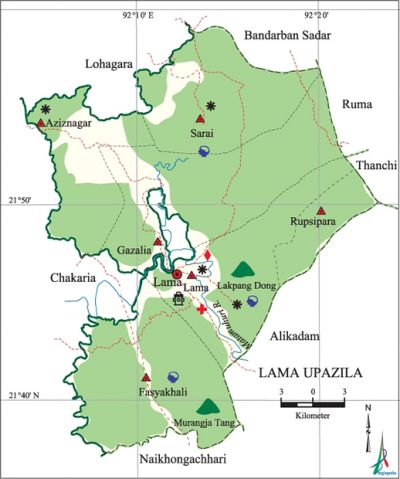Lama Upazila
Lama Upazila (bandarban district) area 671.83 sq km, located in between 21°36' and 21°59' north latitudes and in between 92°04' and 92°23' east longitudes. It is bounded by bandarban sadar and lohagara (chittagong) upazilas on the north, naikhongchhari and alikadam upazilas on the south, ruma, thanchi and Alikadam upazilas on the east, chakaria upazila on the west. Lakpang Dang and Muranga Tang Hills of the upazila are notable.
Population Total 108995; male 56610, female 52385; Muslim 77490, Hindu 3018, Buddhist 20395, Christian 6628 and others 1464.
Water bodies Main river: matamuhuri.
Administration Lama Thana was formed in 1923 and it was turned into an upazila in 1985.
| Upazila | ||||||||
| Municipality | Union | Mouza | Village | Population | Density (per sq km) | Literacy rate (%) | ||
| Urban | Rural | Urban | Rural | |||||
| 1 | 7 | 18 | 343 | 19014 | 89981 | 162 | 50.3 | 30.3 |
| Municipality | ||||||||
| Area (sq km) |
Ward | Mahalla | Population | Density (per sq km) |
Literacy rate (%) | |||
| 13.87 | 9 | 34 | 19014 | 1371 | 50.3 | |||
| Union | ||||||||
| Name of union and GO code | Area (acre) | Population | Literacy rate (%) | |||||
| Male | Female | |||||||
| Aziznagar 15 | 23680 | 5420 | 5154 | 46.4 | ||||
| Gajalia 47 | 30720 | 6314 | 5580 | 22.3 | ||||
| Fasyakhali 31 | 47360 | 12708 | 12228 | 28.5 | ||||
| Rupshipara 68 | 22400 | 5974 | 5591 | 25.8 | ||||
| Lama 63 | 18560 | 4255 | 4236 | 28.5 | ||||
| Sarai 79 | 23040 | 5970 | 5261 | 31.3 | ||||
| Faitang 27 | 16000 | 6119 | 5171 | 32.3 | ||||
Source Bangladesh Population Census 2011, Bangladesh Bureau of Statistics.

War of Liberation During the war of liberation Lama upazila was under Sector 1. The Pak army conducted mass killing and heavy plundering; they also set many houses of the upazila on fire. Freedom fighters had encounters with Pak army at a number of places of the upazila and notable among these were the encounters at Lama Police Station, the camp of freedom fighters at Trishdeba and the Pak army camp at Purikkha.
For details: see লামা উপজেলা, বাংলাদেশ মুক্তিযুদ্ধ জ্ঞানকোষ (Encyclopedia of Bangladesh War of Liberation), বাংলাদেশ এশিয়াটিক সোসাইটি, ঢাকা ২০২০, খণ্ড ৯।
Religious institutions Mosque 35, temple 5, church 15, keyang 18.
Literacy rate and educational institutions Average literacy 34.0%; male 36.6%, female 31.1%. Educational institutions: college 1, secondary school 6, primary school 74, community school 5, madrasa 4. Noted educational institutions: Lama Government High School, Chambi High School,' Lama Adarsha Primary School, Ramthui Para Government Primary School, Linejhiri Government Primary School.
Cultural organisations Library 2, music academy 1, auditorium 1, cinema hall 1, playground 3.
Tourists spots Merenga, Memorial Christan Mission.
Main sources of income Agriculture 62.18%, non-agricultural labourer 7.4%, industry 0.46%, commerce 10.82%, transport and communication 0.61%, service 7.52%, construction 0.6%, religious service 0.27%, rent and remittance 0.31% and others 9.83%.
Ownership of agricultural land Landowner 50.09%, landless 49.91%; agricultural landowner: urban 37.12% and rural 52.74%.
Main crops Paddy, tobacco, potato, ginger, nut, turmeric, sesame, cotton, vegetables.
Main fruits Banana, jackfruit, litchi, papaya.
Fisheries, dairies and poultries Poultry 1.
Communication facilities Roads: pucca 52 km, semi-pucca 35 km, mud road 160 km.
Noted manufactories Rice mill, match factory, saw mill.
Cottage industries Weaving, wood work, bamboo and cane work.
Hats, bazars and fairs Hats and bazars are 5, most noted of which are Lama Bazar, Gajalia Bazar, Kiajupara Bazar, Rupasi Bazar and Aziznagar Bazar.
Main exports Banana, jackfruit, bamboo, cotton, sesame, ginger, yarn, turmeric.
Access to electricity All the unions of the upazila are under rural electrification net-work. However 22.9% of the dwelling households have access to electricity.
Sources of drinking water Tube-well 62.6%, tap 1.3% and others 36.1%.
Sanitation 23.2% of dwelling households of the upazila use sanitary latrines and 41.9% of dwelling households use non-sanitary latrines; 34.9% of households do not have latrine facilities.
Health centres Upazila health complex 1, satellite clinic 3, veterinary hospital 1.
NGO activities Operationally important NGOs are brac, asa, proshika. [Atikur Rahman]
References Bangladesh Population Census 2001 and 2011, Bangladesh Bureau of Statistics; Cultural survey report of Lama Upazila 2007.
